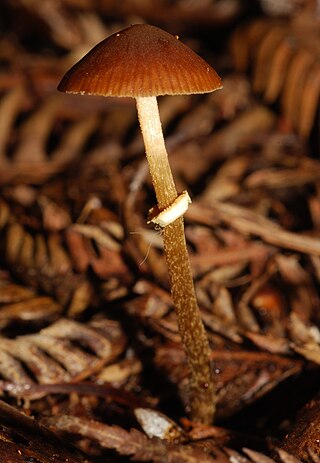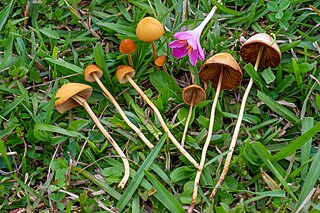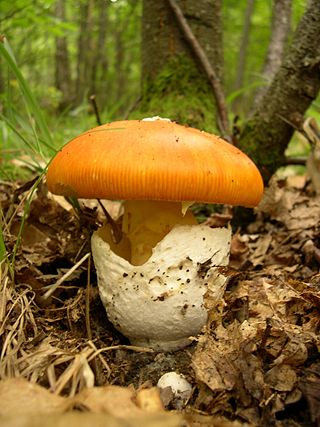
Caenorhabditis elegans is a free-living transparent nematode about 1 mm in length that lives in temperate soil environments. It is the type species of its genus. The name is a blend of the Greek caeno- (recent), rhabditis (rod-like) and Latin elegans (elegant). In 1900, Maupas initially named it Rhabditides elegans. Osche placed it in the subgenus Caenorhabditis in 1952, and in 1955, Dougherty raised Caenorhabditis to the status of genus.

Baeocystin is a zwitterionic alkaloid and analog of psilocybin. It is found as a minor compound in most psilocybin mushrooms together with psilocybin, norbaeocystin, aeruginascin, and psilocin. Baeocystin is an N-demethylated derivative of psilocybin, and a phosphorylated derivative of 4-HO-NMT (4-hydroxy-N-methyltryptamine). The structures at right illustrate baeocystin in its zwitterionic form.

Conocybe is a genus of mushrooms with Conocybe tenera as the type species and at least 243 other species. There are at least 50 different species in North America.

Pholiotina rugosa is a common mushroom which is widely distributed and especially common in the Pacific Northwest of the United States. It grows in woodchips, flowerbeds and compost. It has been found in Europe, Asia and North America. It contains the same mycotoxins as the death cap. It is more commonly known as Conocybe filaris as this is the name it is likely to appear under in field guides. However, Conocybe filaris is a junior synonym of Pholiotina rugosa. Pholiotina rugosa has also been placed in the genus Conocybe, but its morphology and a 2013 molecular phylogenetics study place it in the genus Pholiotina. Pholiotina fimicola, which grows on dung and rich soil in North America, is a possible synonym. Pholiotina arrhenii has also been considered a possible synonym, but a molecular phylogenetics study found it to be a distinct species.

Conocybe tenera, commonly known as the brown dunce cap or common cone head, is a widely distributed member of the genus Conocybe. This mushroom is the type species for the genus Conocybe.

Pholiotina cyanopus is a species of fungus that contains psychoactive compounds including psilocybin and the uncommon aeruginascin. Originally described as Galerula cyanopus by American mycologist George Francis Atkinson in 1918. It was transferred to Conocybe by Robert Kühner in 1935 before being transferred to Pholiotina by Rolf Singer in 1950. A 2013 molecular phylogenetics study found it to belong to a group of species currently assigned to Pholiotina that are more closely related to Galerella nigeriensis than to Pholiotina or Conocybe. It is likely that it will be moved to a different genus in the future, but this has not happened yet.

Conocybe apala is a basidiomycete fungus and a member of the genus Conocybe. It is a fairly common fungus, both in North America and Europe, found growing among short green grass. Until recently, the species was also commonly called Conocybe lactea or Conocybe albipes and is colloquially known as the white dunce cap or the milky conecap. Another common synonym, Bolbitius albipes G.H. Otth 1871, places the fungus in the genus Bolbitius.

In mycology, a volva is a cup-like structure at the base of a mushroom that is a remnant of the universal veil, or the remains of the peridium that encloses the immature fruit bodies of gasteroid fungi. This macrofeature is important in wild mushroom identification because it is an easily observed, taxonomically significant feature that frequently signifies a member of Amanitaceae. This has particular importance due to the disproportionately high number of deadly poisonous species contained within that family.

The Bolbitiaceae are a family of mushroom-forming basidiomycete fungi. A 2008 estimate placed 17 genera and 287 species in the family. Bolbitiaceae was circumscribed by mycologist Rolf Singer in 1948.

Pholiotina is a genus of small agaric fungi. It was circumscribed by Swiss mycologist Victor Fayod in 1889 for Conocybe-like species with partial veils. The genus has since been expanded to include species lacking partial veils.

Conocybe rickenii is a mushroom from the genus Conocybe. Its edibility is disputed, and it has the appearance of a typical little brown mushroom with a small, conical cap, and long, thin stem. In colour, it is generally a cream-brown, lighter on the stem, and it has a thin layer of flesh with no distinct smell or taste. It is a coprophilous fungus, feeding off dung and it is most common on very rich soil or growing directly from dung. It can be found in Europe, Australia and Pacific islands.

Coprophilous fungi are a type of saprobic fungi that grow on animal dung. The hardy spores of coprophilous species are unwittingly consumed by herbivores from vegetation, and are excreted along with the plant matter. The fungi then flourish in the feces, before releasing their spores to the surrounding area.
Conocybe siligineoides, also known as cone caps, Ya'nte, Ta'a'ya, or Tamu, is a species of macro-fungus in the family Bolbitiaceae. It has seldom been observed by the mycological community with all specimens having been collected in Mexico. Originally reported as a sacred mushroom, no chemical studies have been undertaken on this species although other members of the same genus have been shown to contain psilocybin, which causes strong hallucinations. They are crushed, dried, and used in tea, and consumed fresh.
Roy Watling, PhD., DSc, FRSE, F.I.Biol., C.Biol., FLS is a Scottish mycologist who has made significant contributions to the study of fungi both in the identification of new species and correct taxonomic placement, as well as in fungal ecology.

Hirticlavula is a fungal genus in the family Clavariaceae. It contains a single described species, Hirticlavula elegans. Formally described in 2014, the fungus has been collected from Norway and Denmark. H. elegans produces white fruit bodies up to 1.1 millimetres (0.043 in) in height. Each fruit body contains a fertile head atop a hairy stem. The fruit bodies grow directly from dead bark or wood, where they feed as saprotrophs. Both morphological and ecological details are distinctive when compared to other clavarioid fungi.

Conocybe aurea is a basidiomycete fungus in the family Bolbitiaceae.
Conocybe moseri is a mushroom species in the family Bolbitiaceae. It was described as new to science in 1980 by mycologist Roy Watling, from collections made in France. The specific epithet moseri honours Austrian mycologist Meinhard Moser. The fungus has been reported from the United Kingdom, growing in grassy areas, fields, and edges of woods. In 1995, it was recorded from Switzerland, from Ukraine in 2007, and from Russia in 2007. It was reported from India in 2015, where it was found growing on cattle dung.
Conocybe velutipes is a species of mushroom in the Bolbitiaceae family. It contains the psychedelic alkaloids psilocybin and psilocin.













